While some gardeners shy away from full-sun locations, you’ll find these spots perfect for creating stunning flower displays that thrive in intense heat. Your success depends on selecting the right plants that don’t just survive but flourish when temperatures soar. From towering sunflowers to low-growing portulacas, there’s a sun-loving bloom for every garden style and space. Let’s explore these heat-hardy champions that’ll transform your sunniest spots into vibrant oases.
Contents
- 1 Sunflower’s Bright Yellow Petals
- 2 Portulaca’s Drought-Hardy Blooms
- 3 Zinnia’s Long-Lasting Color
- 4 Lantana’s Heat-Loving Clusters
- 5 Coneflower’s Purple Summer Display
- 6 Marigold’s Orange Summer Blooms
- 7 Lavender’s Fragrant Purple Spikes
- 8 Red Salvia’s Fiery Spires
- 9 Gaillardia’s Sun-Loving Daisies
- 10 Geranium’s Heat-Tolerant Petals
Sunflower’s Bright Yellow Petals
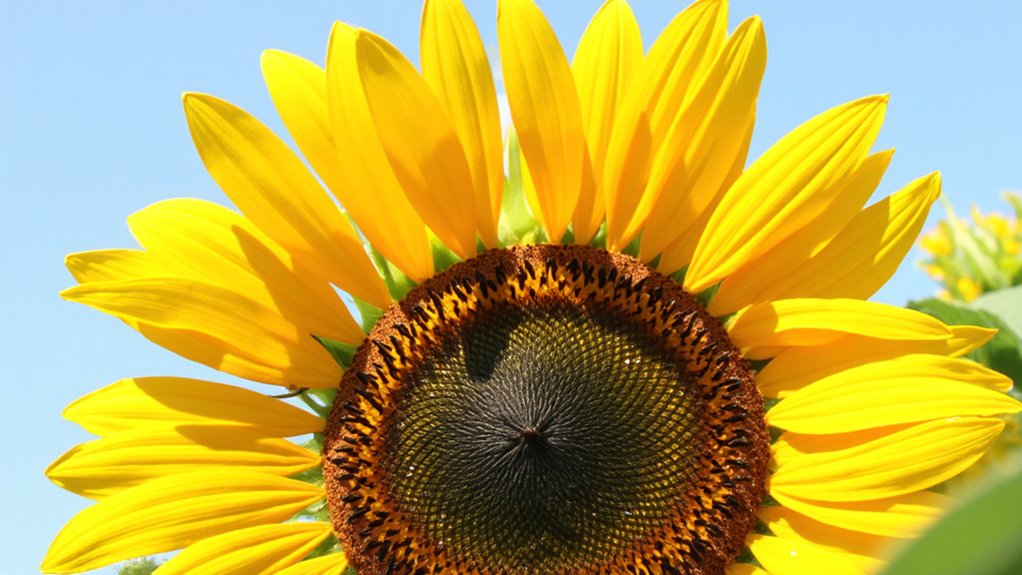
The iconic sunflower, with its brilliant yellow petals stretching up to 12 inches across, stands as a perfect choice for sun-drenched garden spaces. You’ll find these sturdy plants thriving in temperatures up to 95°F, making them ideal for those challenging spots where other flowers might wither.
To get the most from your sunflowers, plant them 6 inches deep and 6 inches apart in well-draining soil. They’ll need at least 6-8 hours of direct sunlight daily, and you’ll want to water them deeply but infrequently, about twice a week.
Watch for the distinctive center disk to develop, which will eventually produce edible seeds. You can expect your sunflowers to reach maturity in 80-120 days, depending on the variety you’ve chosen, with heights ranging from 2 to 12 feet tall.
Portulaca’s Drought-Hardy Blooms
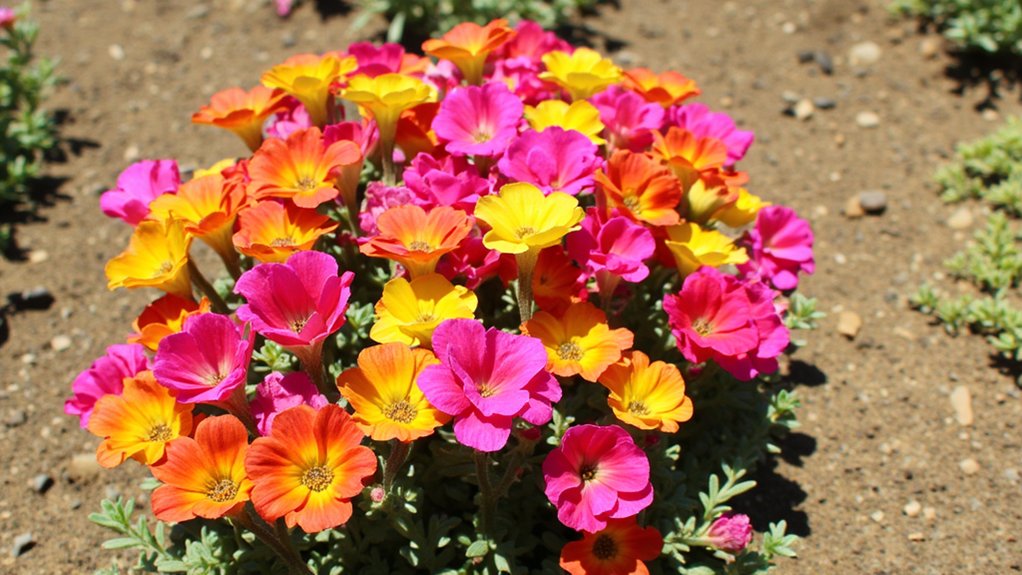
Because portulaca thrives in searing heat and sandy soils, you’ll find it’s one of your most reliable flowering options for drought-prone gardens. These low-growing succulents, also known as moss roses, spread 6-8 inches wide and produce vibrant blooms in orange, pink, yellow, and white from early summer through first frost.
You’ll want to plant portulaca in well-draining soil with 6-8 hours of direct sunlight daily. Space plants 8-12 inches apart, and don’t worry about frequent watering – they’ll only need moisture every 7-10 days once established.
The flowers open fully during sunny days and close at night or on cloudy days. For continuous blooming, remove spent flowers regularly, and trim back leggy growth by one-third to encourage bushier plants with more abundant blossoms.
Zinnia’s Long-Lasting Color
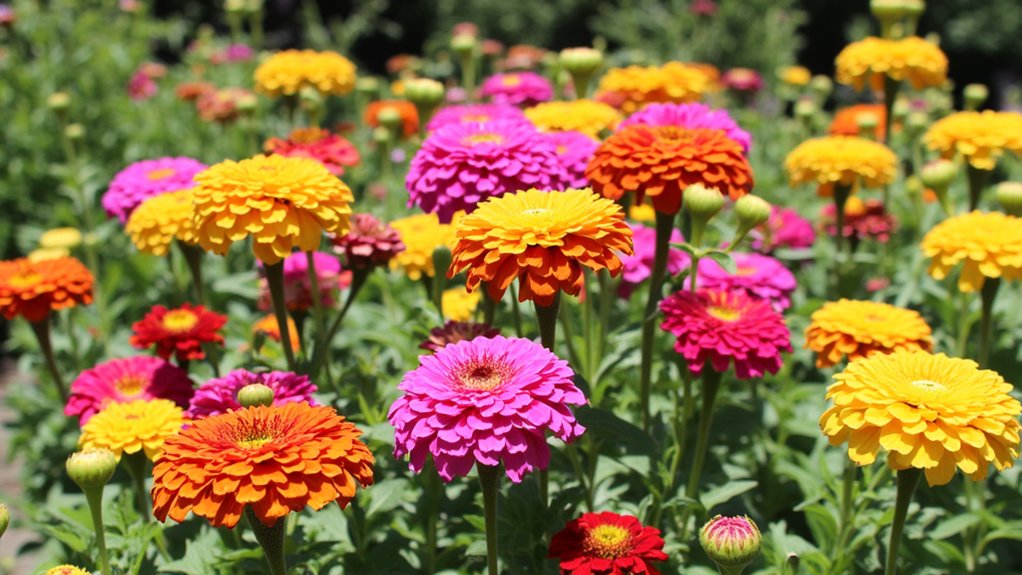
While portulaca offers ground-level color, zinnias stand tall and proud in sun-drenched gardens, reaching heights of 6-36 inches depending on variety. You’ll find these heat-loving annuals bloom continuously from early summer until first frost, producing vivid flowers in nearly every color except blue.
Plant your zinnias in well-draining soil after the last spring frost, spacing them 6-12 inches apart. They’ll germinate quickly in warm soil, typically showing first blooms within 60 days of sowing. For best results, deadhead spent flowers regularly and water at soil level to prevent powdery mildew.
You can choose from three main types: single-flowered, semi-double, or fully double blooms. The Profusion series offers excellent disease resistance, while the giant Benary’s series produces stunning 4-6 inch flowers perfect for cutting.
Lantana’s Heat-Loving Clusters
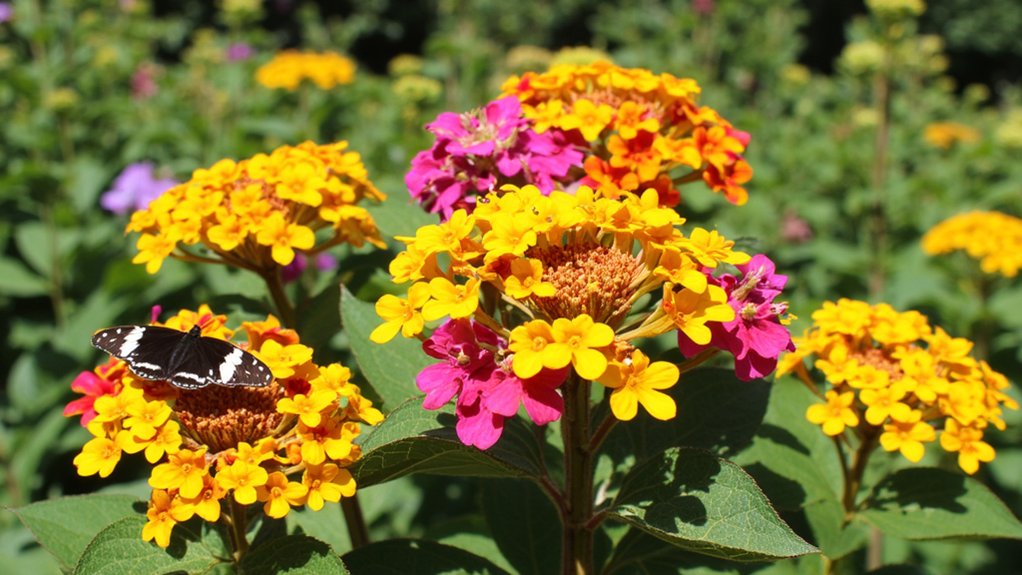
Popular among butterfly gardeners, lantana thrives in scorching conditions where other flowers might wilt. You’ll find these hardy plants producing clusters of tiny, multicolored blooms in shades of yellow, orange, red, and purple throughout the growing season, often until the first frost.
Plant your lantana in well-draining soil 2-3 feet apart, as they’ll spread 3-4 feet wide when mature. They don’t need much water once established – just an inch per week will keep them blooming profusely.
You can trim back the stems by one-third in midsummer to encourage bushier growth and more flowers. While they’re usually grown as annuals in zones 3-7, you’ll find they’re actually perennial in zones 8-11, where they’ll return year after year with minimal maintenance.
Coneflower’s Purple Summer Display
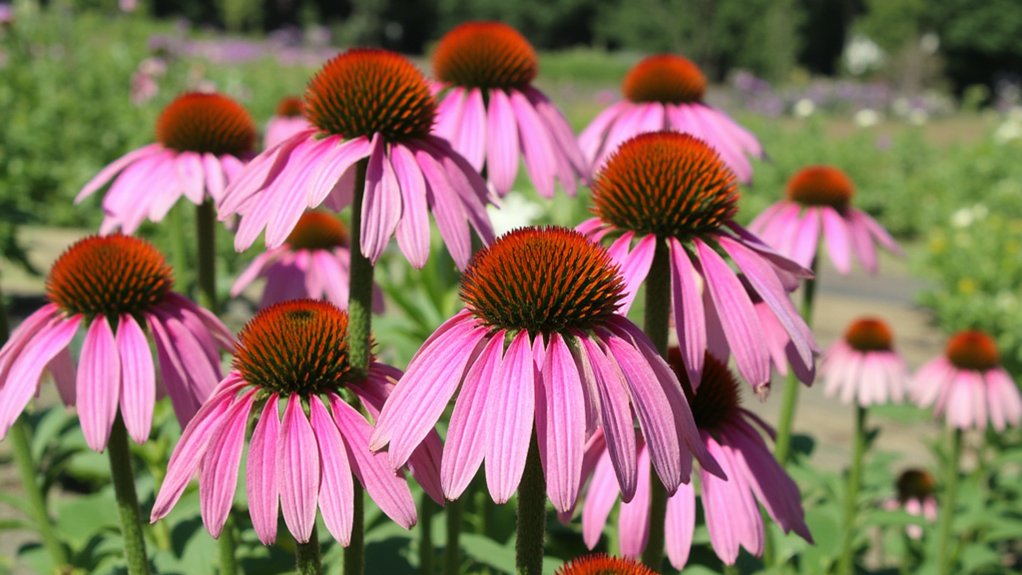
The stately purple coneflower stands as one of summer’s most reliable performers in sun-drenched gardens. You’ll find these native perennials blooming from June through September, with their distinctive cone-shaped centers rising 3-4 inches above vibrant purple petals.
Plant your coneflowers 18-24 inches apart in well-draining soil, and you won’t need to pamper them. They’ll thrive in temperatures up to 95°F and actually prefer hot, dry conditions once established. Water deeply but infrequently to encourage deep root growth.
Don’t deadhead all the spent blooms – leave some standing through fall and winter. The seed heads will attract goldfinches and provide winter interest in your garden. For continuous blooming, though, you can remove about half the spent flowers during peak season.
Marigold’s Orange Summer Blooms
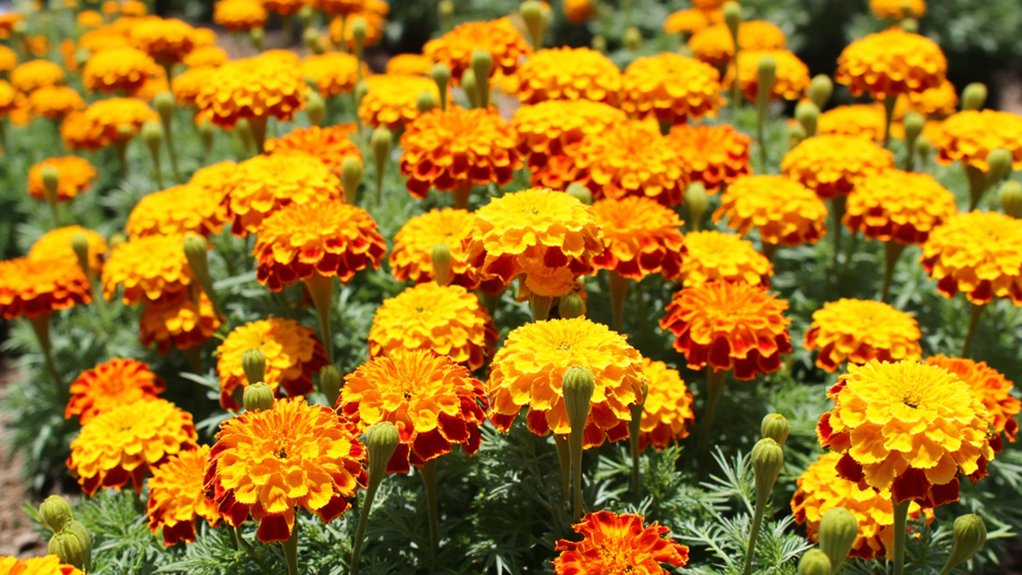
Much like their purple garden companions, marigolds bring vibrant color to sun-soaked spaces with their abundant orange and yellow blooms. You’ll find these hardy annuals reaching heights of 6-36 inches, depending on the variety you choose, with French marigolds staying compact while African types grow taller.
Plant your marigolds 6-8 inches apart in well-draining soil after the last spring frost, and you’ll enjoy their cheerful display through summer’s heat until autumn’s first freeze. They’re surprisingly drought-tolerant once established, though they’ll perform best with weekly watering at the base.
For continuous blooming, deadhead spent flowers every 5-7 days, pinching them off at the stem junction. You’ll notice they emit a distinctive scent that naturally deters many garden pests, making them excellent companion plants for your vegetable garden.
Lavender’s Fragrant Purple Spikes
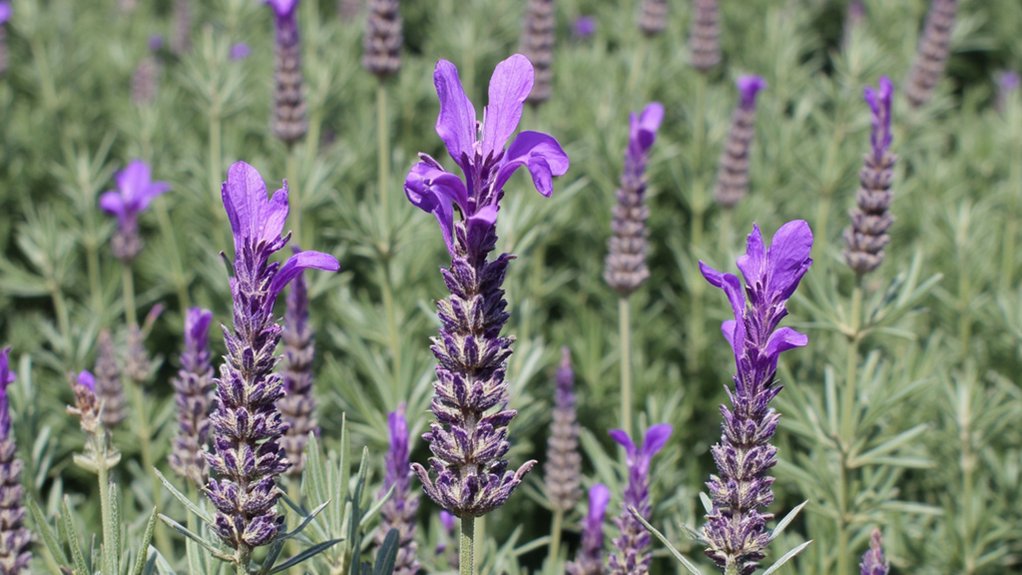
Beloved for its soothing fragrance and drought tolerance, lavender thrives in full sun locations where many other plants struggle. You’ll find it’s a perfect choice for hot, dry areas with well-draining soil and 6-8 hours of direct sunlight daily.
Plant your lavender 18-24 inches apart in spring or early fall, keeping the crown slightly above soil level to prevent rot. They’ll reach mature heights of 2-3 feet, creating stunning purple spikes from June through August.
You can maximize your lavender’s blooming potential by pruning it back by one-third in early spring, just as new growth emerges. Don’t forget to harvest the fragrant stems when flowers are half-open – that’s when they’re most potent for drying and using in sachets or potpourri.
Red Salvia’s Fiery Spires
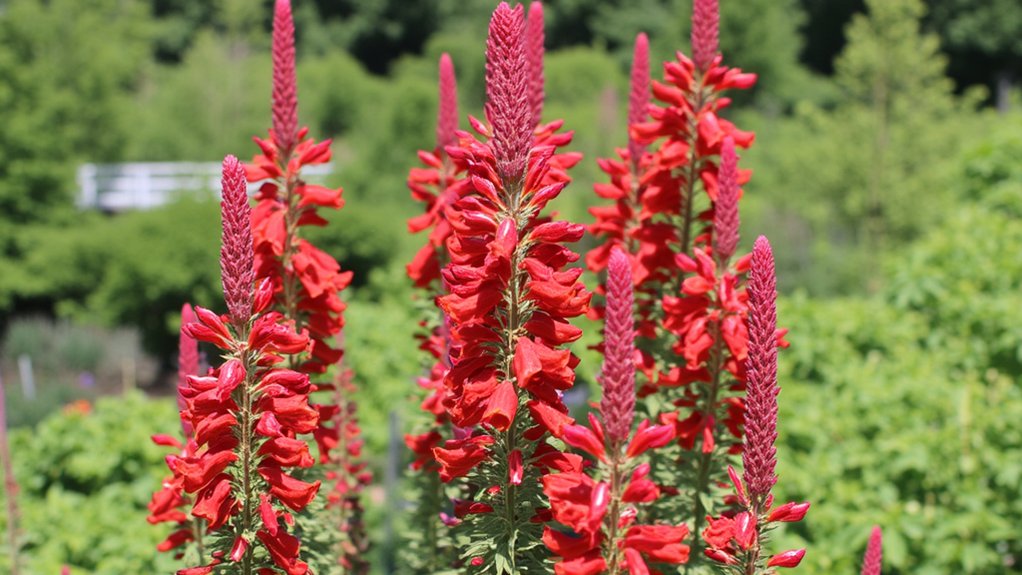
Striking red salvia spikes add dramatic vertical interest to sunny garden beds while attracting scores of hummingbirds and butterflies throughout the growing season. You’ll find these heat-loving perennials grow 18-36 inches tall, creating bold splashes of color from early summer through fall.
Plant your salvias 12-18 inches apart in well-draining soil, and you’ll watch them establish quickly in temperatures above 65°F. They’re drought-tolerant once established, needing just 1 inch of water weekly during the growing season.
To keep your red salvias blooming consistently, deadhead spent flower spikes by cutting them back to the nearest set of leaves. You can divide established plants every 3-4 years in early spring, just as new growth emerges, to maintain vigor and spread their fiery display throughout your garden.
Gaillardia’s Sun-Loving Daisies
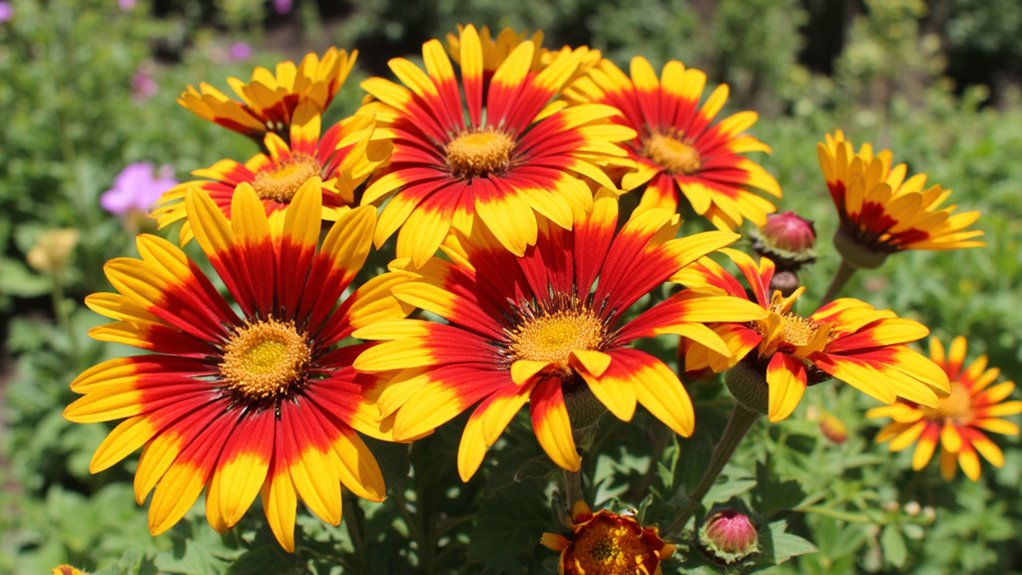
These hardy daisy-like blooms, also known as blanket flowers, thrive in the same sun-drenched conditions as salvias while offering a different visual dimension to your garden. You’ll find gaillardias displaying rich combinations of red, orange, and yellow petals that resemble pinwheels, typically spanning 2-3 inches in diameter.
Plant your gaillardias 12-18 inches apart in well-draining soil, and they’ll reward you with continuous blooms from early summer through fall. Don’t worry about deadheading every flower – these low-maintenance perennials will keep blooming regardless, though removing spent blooms can increase production.
For best results, water your gaillardias deeply but infrequently, about once weekly. They’re drought-tolerant once established and actually prefer slightly lean soil, so you won’t need to fertilize them regularly.
Geranium’s Heat-Tolerant Petals
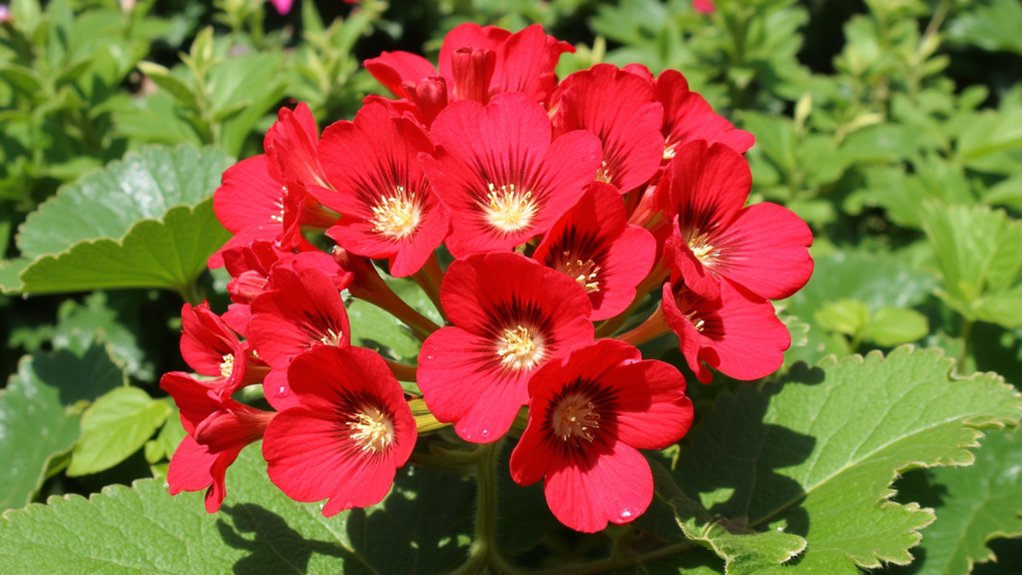
While many summer flowers wilt under intense sun exposure, geraniums stand proudly as heat-loving champions in gardens worldwide. You’ll find these resilient bloomers thriving in temperatures up to 95°F, producing clusters of vibrant flowers in shades of red, pink, white, and salmon from spring through fall.
Plant your geraniums 12-24 inches apart in well-draining soil with a pH between 6.0 and 6.5. They’ll need at least 6 hours of direct sunlight daily to maintain their prolific blooming habits. Water deeply when the top inch of soil feels dry, but don’t overwater – geraniums prefer slightly dry conditions.
For continuous blooms, deadhead spent flowers and pinch back leggy stems. You can expect 4-6 weeks of vibrant color from each flower cluster, with new ones forming throughout the growing season.
